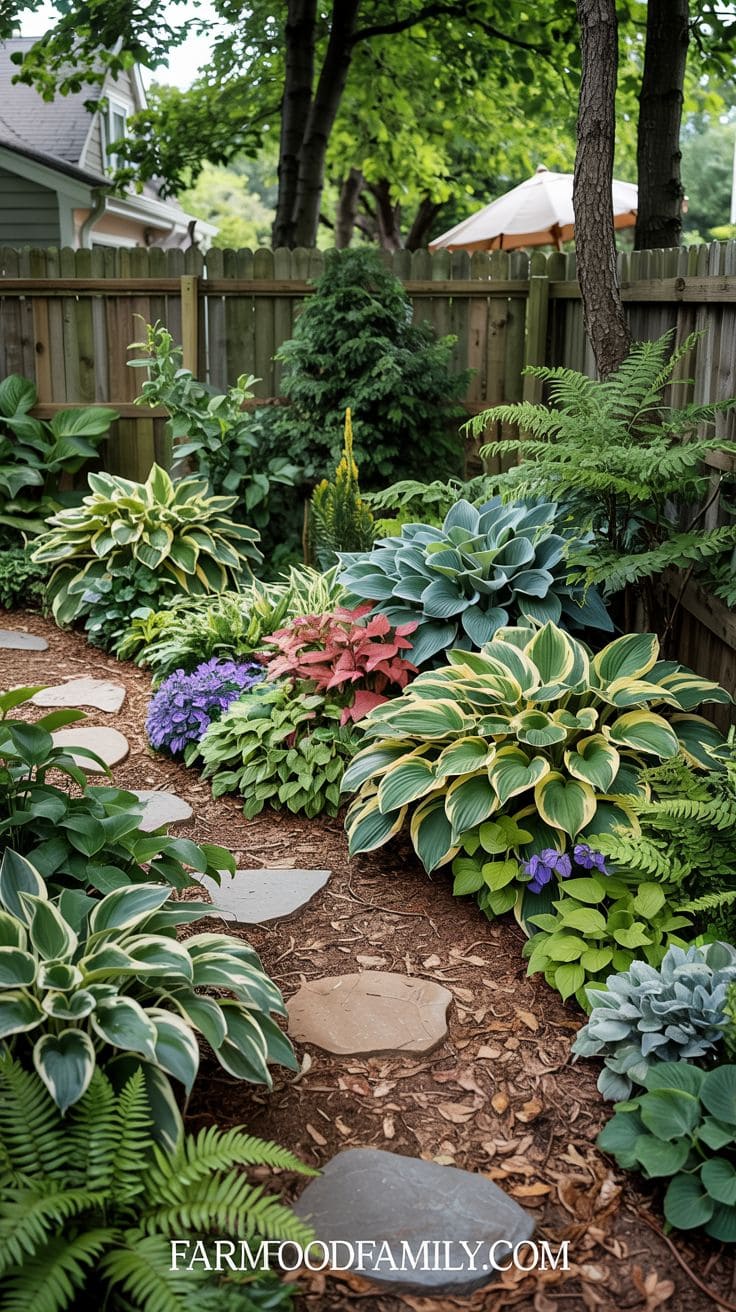Hostas are the go-to heroes of shade gardens, and for good reason. Their wide, textured leaves come in a rich variety of greens, blues, and creamy whites, offering lush, low-maintenance beauty that thrives in spots many other plants struggle with.
Their dependable nature and layered foliage make them ideal for both classic and modern garden styles.
Let’s explore these hosta landscaping ideas that show you how you can elevate your outdoor space using hostas in creative, beautiful, and versatile ways.
Hosta Landscaping Ideas
1. Woodland-inspired Border Garden

Create a shaded border that resembles a secret woodland refuge with hostas as the foundation.
Combine several types to add visual depth and texture. Plant them in sweeping curves alongside ferns, astilbe, and coral bells to create a delicate, layered look.
Mulch with bark or pine straw to improve the forest floor appearance, and try adding small natural stepping stones that meander through the vegetation.
This method works well behind fences, beneath big trees, or beside a shaded patio.
It produces a cool, peaceful visual flow that makes your yard feel tucked away and serene, yet it requires minimal upkeep once established.



2. Hostas as Pathway Edging

Hostas are wonderful edging plants, particularly when used to soften the lines of a path.
Their mounding shape flows smoothly over borders, enticing you to walk beside them. Use a single variety for a clean, beautiful appearance, or vary between types for additional visual movement.
To add contrast, pair large-leafed hostas with fine-textured plants such as decorative grasses or dwarf ferns.
This concept works best in slightly shaded walks that meander through gardens or lead to dining spots.
You may even use solar lights to accent the route at twilight, giving the glossy leaves a subtle shine.
The end effect is a garden feature that feels thoughtful, tranquil, and welcoming as you walk through it.



3. Seasonal Focal Point Using Variegated Hostas

Make variegated hostas the star of a seasonal display by planting them in eye-catching containers or around seasonal flowers.
Their bright, creamy margins pop against summer blooms and even hold their own through fall.
You can spotlight a single massive hosta in a container by itself or use a ring of them to frame a decorative garden item like a birdbath or statue.
This gives your garden dynamic focal points without overwhelming the space.
It’s a great way to bring variety into a shade garden that might otherwise rely on green alone.



4. Planting Hostas Under Trees

The shady region beneath older trees can be challenging to plant, yet hostas thrive where grass and sun-loving flowers fail.
Begin by removing any residual turf, then replenish the soil with compost to assist the roots compete with the tree.
Plant hostas in clusters to create an overlapping leaf mat beneath the canopy.
Use contrasting tones, such as rich greens, powdered blues, or cream-edged whites, to break up the visual mass and provide dimension.
Grounding items, such as huge stones or rustic garden sculptures, can offer flair.
This setup is both polished and organic, transforming a problem area into one of the most attractive focus spots in your yard.



5. Hosta Island Beds for Open Lawns

Plant a hosta island in the center of a lawn to form a sculptural garden bed.
Choose a spherical or oval form and fill it with numerous layers of hostas, using taller varieties like ‘Sum and Substance’ in the center and more compact ones along the sides.
To add seasonal color, use shade-tolerant blooming plants such as bleeding heart or Japanese forest grass.
This technique works nicely in front yards or large open spaces that require softening without blocking the view.
For neat definition, ring the bed with mulch or stone, then trim the grass around it to maintain balance.
It catches the eye and gives your grass a more purposeful, planted appearance.






























6. Shade Garden Oasis

7. Hosta Border Edging

8. Hosta Ground Cover

9. Container Gardening with Hostas

10. Hosta Rock Garden

11. Hosta Water Feature

12. Hosta Woodland Garden

13. Hosta in Mixed Borders

14. Hosta Hedge

15. Hosta with Spring Bulbs

16. Hosta and Groundcovers

17. Hosta in Formal Gardens

18. Hosta in Small Gardens

19. Hosta and Shrub Combinations

20. Hosta Pathways





























Conclusion



















From borders to containers, and woodland paths to backyard focal points, hostas prove they’re more than just filler plants. Their timeless shape, soothing palette, and versatility give you endless design opportunities, no matter the layout you’re going for.
With just a few thoughtful combinations and placements, hostas can turn even the shadiest corners of your yard into something stunning.
If this list helped you out, leave a comment with your thoughts below and make sure to share it with your family and friends!

